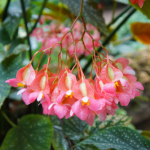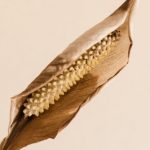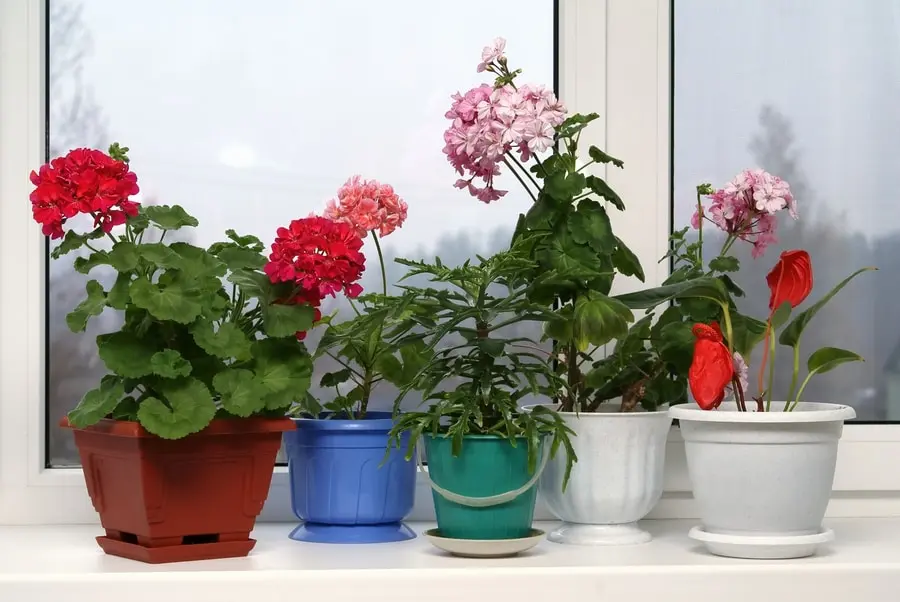
If you’re new to houseplants (or at least the blooming variety), these easy to grow indoor flowers provide visual appeal while being easy enough for a beginner. I’ve chosen plants for this list that require the least amount of fuss and tolerate the most mistakes and neglect while remaining attractive.
Here are my top picks for the best indoor flowers for beginners:
- African Violet
- Begonia
- Geranium
- Peace Lily
- Amaryllis
- Lipstick Plant
- Cape Primrose
- Kaffir Lily
- Flame Violet
- Wax Flower
Let’s take a closer look at each of these. Think about the environment in your home – light, humidity, window location, temperature, etc. – as you choose the right plant for you.
African Violet
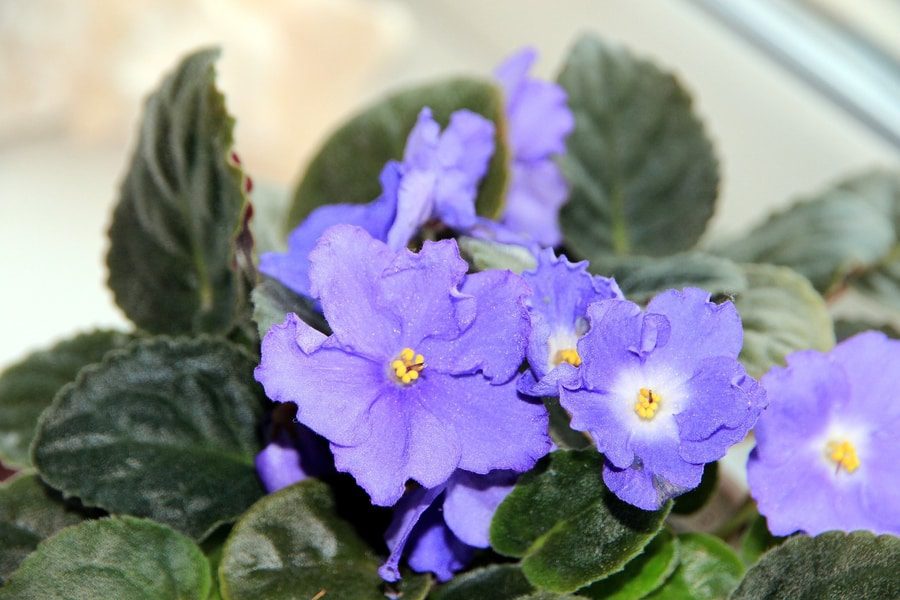
One of the most popular indoor flowers, African Violet is native to the coastal woods of Africa. It thrives if given enough light and humidity. Once placed in the right location, don’t need much attention from you to bloom.
Upkeep includes regular watering to keep the soil moist and feeding about once a month with a good quality fertilizer.
| Light | Bright, indirect light. Place in a sunny east- or west-facing window or under artificial lights for 14 to 16 hours per day. |
| Temperature | Daytime temperatures of 70 – 75 degrees F and nighttime temperatures above 65 degrees F. Temps should never drop below 60 degrees F. |
| Humidity | High Humidity. Place near a humidifier or on a humidity tray (a shallow tray filled with pebbles and water). Misting is not recommended. |
| Water | Moist, but not wet soil. Never allow soil to completely dry. Water as needed to keep the soil consistently moist. |
| Fertilizer | High phosphorus 15-30-15 fertilizer once every four to six weeks to encourage blooms. |
Begonia
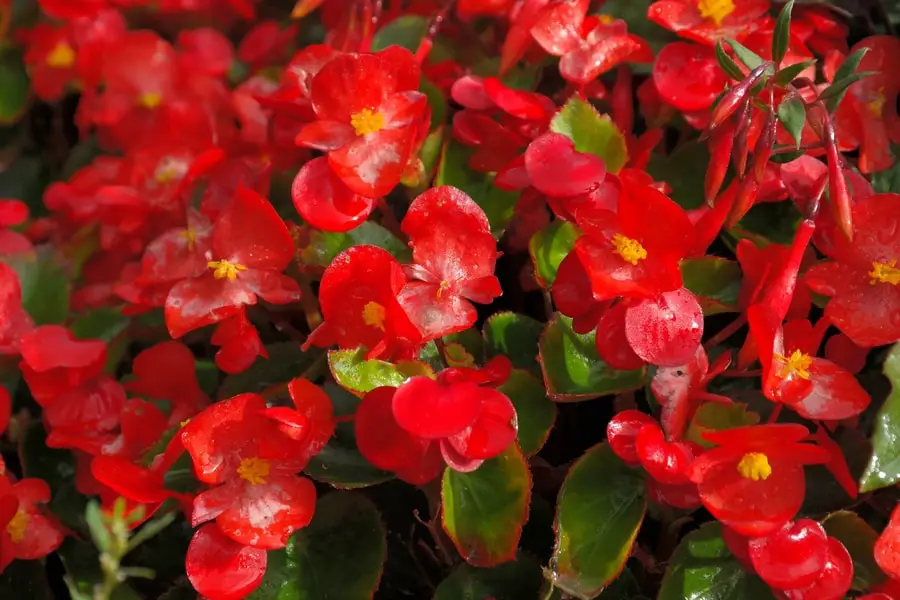
Easy houseplants for beginners, begonias are available in a range of different species. Many of them tolerate low light and are rarely affected by pests or disease. With adequate humidity and light, begonias produce beautiful flowers with little effort and gorgeous foliage when they aren’t in bloom. Angelwing begonias and rieger begonias make especially good houseplants.
Upkeep includes watering once the soil dries out, misting daily to increase humidity, and feeding regularly during active growth.
| Light | Varies by type, but generally bright, indirect light. Too much sun will burn the foliage. |
| Temperature | Warm temperatures between 62 and 72 degrees F for the best results. Never allow the temperature to drop below 55 degrees. |
| Humidity | High humidity with daily misting recommended. Place near a humidifier and/or on a humidity tray to combat dry indoor air. |
| Water | Moist, but not wet soil. Allow to dry between waterings and then water thoroughly. Don’t allow plants to sit in water. |
| Fertilizer | Balanced fertilizer at half strength applied every other watering during active growth. Do not feed while plant is dormant. |
Geranium
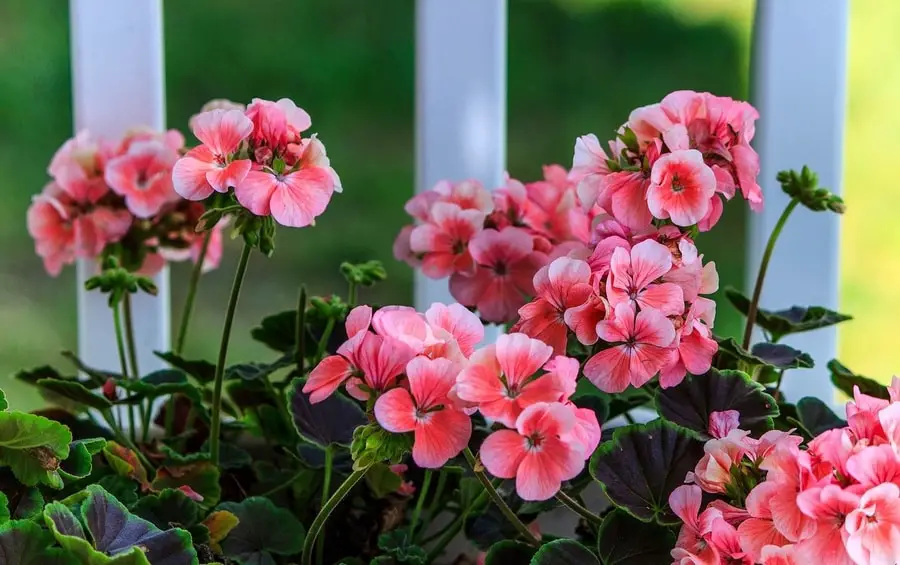
Pelargonium sp., commonly known as Geraniums, are excellent indoor plants for beginners. They’re easy to grow and will flower continuously throughout the year with proper care and enough light. Many different cultivars are available, and you can find them in hanging baskets or pots. Geraniums are great starter flowers if you don’t have a humidifier and need something less tropical.
Upkeep includes watering only when the soil is mostly dry and feeding twice a month during the growing season. Geraniums have some of the lowest care requirements of any plants on our list.
| Light | Bright light is essential. South- and west-facing windows are best, especially during winter. Supplement with artificial light if you can’t provide strong, natural light. |
| Temperature | Daytime temperatures of 65 to 70 degrees and nighttime temperatures no lower than 55 degrees F. |
| Humidity | They typically don’t need any additional humidity to thrive indoors. If humidity is too high, it can cause oedema. Place away from plants that require higher humidity levels. |
| Water | Water only as needed, allowing soil to dry out between waterings. Check to see if the soil is dry to a depth of 4 to 6 inches, and then water thoroughly. |
| Fertilizer | Twice a month with a balanced or high-phosphorus water soluble fertilizer every two weeks from March through October. |
Peace Lily

A low-light staple, peace lily (Spathiphyllum) is one of the easiest flowers to grow indoors. It’s even been called the “perfect houseplant” due to its low care requirements and beauty. The large white flower consists of a white outer shell and an inner white flower stalk, known as a spadix. Peace lily is also very forgiving if you forget to water it. It will thrive with some indirect light and high humidity.
Upkeep includes watering to keep the soil moist, feeding once or twice a year when new blooms appear, and removing spent flowers and leaves that yellow with age.
| Light | Bright, indirect light or filtered light. Will tolerate low light, but it may flower less often. Will not tolerate direct sunlight. |
| Temperature | Temperatures of 65 to 75 degrees F are perfect. Never allow temperatures to drop below 60 degrees F. |
| Humidity | High humidity. Place near a humidifier or on a humidity tray filled with pebbles and water. If humidity is too low, leaves may turn brown at the edges. |
| Water | Moist, but not wet soil. If the plant dries out and begins to droop, it will usually rebound with a good watering. Don’t allow plant to sit in water or become waterlogged. |
| Fertilizer | Fertilize once or twice per year when plants are blooming. Peace lily doesn’t need much fertilizer. |
Amaryllis

A favorite holiday plant, Amaryllis is a bulb that produces large flowers up to six inches across that can last for two weeks or longer. The plants are available in a variety of different colors from red and pink to yellow and white. Many hybrids are also bred for multicolor blooms.
Upkeep includes regular watering during the blooming period, feeding after blooms fade, and initiating dormancy every year by moving the plant to a cool, dry place and letting it rest for 6-8 weeks. This flower requires the most upkeep of all the flowers on our list, but I still consider it beginner-friendly because it’s still very easy to grow.
| Light | Bright light with some direct sun during active growth. A south-facing window is ideal. Move out of direct light while blooming to prolong flowering. |
| Temperature | Typical room temperatures during active growth. Move plants to a cool, dry location with temperatures of 40 – 50 degrees F (like in the basement) to induce dormancy. |
| Humidity | Medium humidity. Keep in a room with a humidifier if possible. |
| Water | Moist, but not wet soil. Allow the top ½-inch of soil to dry out between waterings. Regular watering required during blooming and less after flowers fade. |
| Fertilizer | Feed after flowers have faded with a balanced houseplant fertilizer once every four to six weeks until dormancy. |
Lipstick Plant

Named for uniquely shaped flowers, lipstick plant (Aeschynanthus radicans) makes a bold statement in any homes. A tropical epiphyte, lipstick plant is actually a vine. Flowers look like red lipstick in a darker lipstick tube. Grow it in a hanging basket in filtered light and you’ll have gorgeous flowers in no time. It’s easy to grow with no significant insect or pest problems.
Upkeep includes daily misting to keep humidity high, regular watering, and fertilizing once a month during the active growing season.
| Light | Bright, indirect light. Don’t place in direct sunlight. Thrives in a sunny window with light filtered by sheer curtains. |
| Temperature | Daytime temperature of 75 to 85 degrees F and nighttime temperature of 65 to 75 degrees F. In winter, cooler temperatures of 55 to 65 degrees F are best. |
| Humidity | High humidity. Place in a room with a humidifier or on a humidity tray. Mist daily with a spray bottle of water. |
| Water | Moist, but not wet soil. During active growth, water any time the top ½-inch of soil becomes dry. Reduce watering in winter to when the top 1-inch of soil becomes dry. |
| Fertilizer | High phosphorus fertilizer such as 15-30-15 applied at half-strength once a month through the growing season. |
Cape Primrose
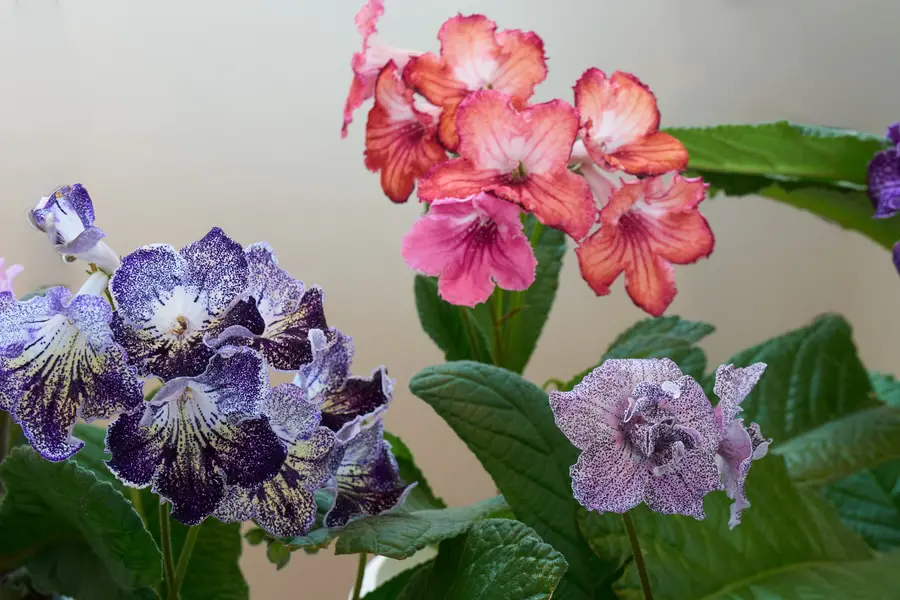
Streptocarpus, also known by the more flattering name of Cape Primrose, is an easy-to-care-for houseplant. It will spring back beautifully from neglect even when the leaves are wilting. Flowers last a long time and come in a variety of different colors from blues and purples to whites, pinks, and reds. They have similar care requirements as African violets.
Upkeep includes regular watering, feeding once a month from spring through fall, and deadheading flowers as the blooms fade. These plants are very easy and rewarding.
| Light | Bright, indirect light. An east- or west-facing window is ideal. Will not tolerate direct sunlight. |
| Temperature | Temperatures of under 75 degrees produce the best results. |
| Humidity | High Humidity. Place near a humidifier or on a humidity tray (a shallow tray filled with pebbles and water). Misting is not recommended. |
| Water | Water regularly once soil dries out. Never allow plants to get soggy feet. Different cultivars may respond differently to soil dryness, but all will spring back if they begin to droop from too little water. |
| Fertilizer | Feed once a month from March through October with a balanced houseplant fertilizer. |
Kaffir Lily
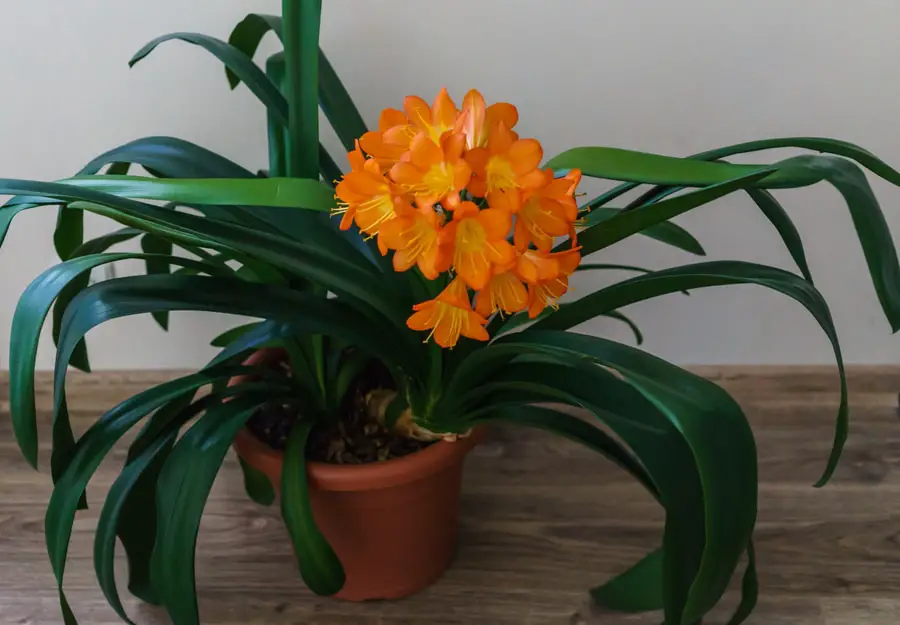
Clivia miniata, also known as Kaffir Lily or Bush Lily, needs very little care to produce dense clusters of red flowers above strap-like, evergreen leaves. But like Amaryllis, it also needs a rest period in fall and winter to initiate blooming. In fact, it’s very similar to Amaryllis in appearance, but with smaller flowers. Clivia is easy to grow, but it requires some planning to make sure it blooms year after year.
Upkeep includes regular watering and monthly feeding during the growing season. Requires a rest period of 6-8 weeks in winter where it needs cool temperatures, sparse watering, and no fertilizer.
| Light | Bright, indirect or filtered light. Will tolerate low light, but it won’t flower. |
| Temperature | Normal home temperatures are adequate for most of the year. Requires 4 to 6 weeks of cool nighttime temperatures – below 50 degrees F but above freezing – to initiate flowering. |
| Humidity | Medium humidity. Keep in a room with a humidifier if possible. |
| Water | Regular water during growing season, allowing soil to become dry to the touch between waterings. Six to eight weeks of very little water after the rest period – just enough to prevent leaves from wilting. |
| Fertilizer | Feed monthly with a balanced houseplant fertilizer at half strength during the growing season. Do not fertilizer during the rest period or the six to eight weeks afterward. |
Flame Violet
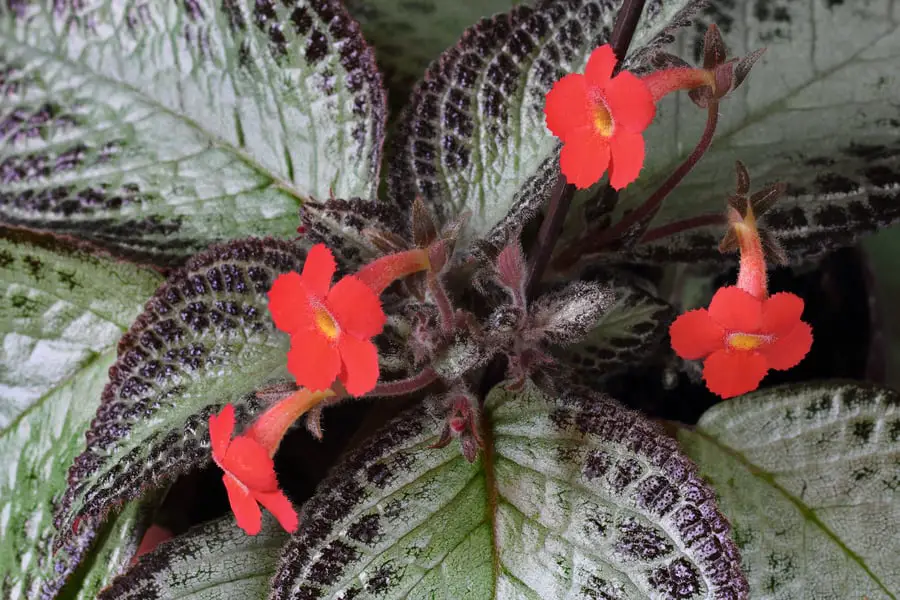
Episcia cupreata, commonly known as Flame Violet, is an easy-care flowering plant in the same family as African Violet. This variety produces bright red to orange flowers (hence the name). Blooms appear in summer through fall, and the foliage makes an attractive display the rest of the year. Other types of Episcia also make good houseplants and have similar care requirements if you can find them.
Upkeep includes moderate watering during and feeding twice a month during summer months. Otherwise, it needs little care with enough sunlight and humidity.
| Light | Bright, indirect light with lots of morning sun. Cannot tolerate direct sunlight. |
| Temperature | Daytime temperatures of 70 to 80 degrees F and nighttime temperatures of 65 to 70 degrees F produce the best results. |
| Humidity | High humidity. Place in a room with a humidifier or on a humidity tray. Do not mist. Flame Violet can’t tolerate water on its leaves. |
| Water | Water moderately in summer to keep the soil moist, less frequently in winter. |
| Fertilizer | Feed once every two weeks with a balanced houseplant fertilizer during the summer months only. |
Wax Flower

Hoya carnosa, also known as Wax Flower or Porcelain Plant, is a climbing houseplant prized for its lovely, sweet scent and beautiful, waxy flowers. It’s easy to grow, but you may need to wrap the leaves around a trellis to make them appear denser You can also plant Wax Flower in a banging basket or pot on a high shelf and let the vines of dark green leaves cascade down.
Upkeep includes misting leaves daily, watering frequently to keep soil moist, and feeding once a month. If you choose to trellis instead of growing in a hanging basket, this requires a little more work. It’s not necessary, however, and I recommend growing it as a hanging plant indoors to minimize upkeep.
| Light | Bright, indirect light is best. |
| Temperature | Daytime temperatures of 68 to 75 degrees F and nighttime temperatures of 60 to 65 degrees are ideal. If temperatures remain very cool for too long, the plant will go dormant. |
| Humidity | High humidity. Place near a humidifier and/or on a humidity tray. Mist the leaves daily to increase humidity around the plant. |
| Water | Moist, but not wet soil. Allow the soil to become dry to the touch before watering again. Don’t let the plant sit in water. |
| Fertilizer | Feed once a month with a balanced, water-soluble houseplant fertilizer at half strength. |


